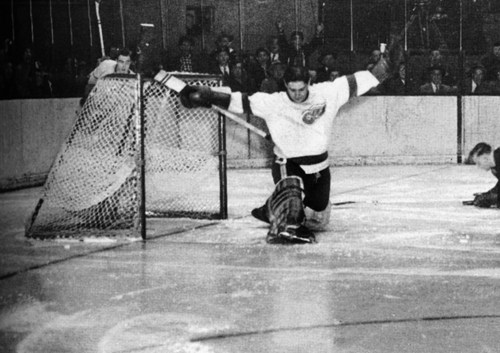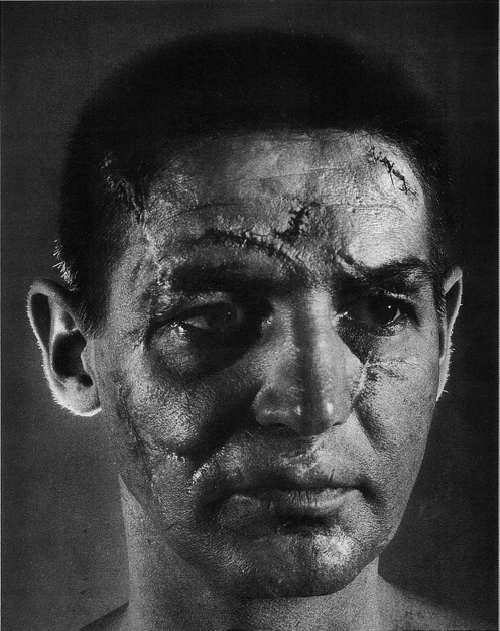Interview
Cutting Down the Angles
In time for the Stanley Cup Finals, a Q&A with Randall Maggs, author of the first great book of hockey poetry.
Introduction
Longtime Detroit Red Wings goalie Terry Sawchuk withstood 21 years of slapshots--12 of which he played without a mask--and by career's end had endured over 600 stitches. In Night Work: The Sawchuk Poems, Randall Maggs pokes underneath that filleted skin to draw a loosely biographical portrait of the hockey legend. R. Emmet Sweeney interviews Maggs about his latest book.

Get the puck out of here: Terry Sawchuk, Randall Maggs's muse. Stan Fischler Collection.
Randall Maggs is a poet and professor of literature, but unlike most academics, he’s a garrulous hockey buff. “When I watched that San Jose–Dallas series I was absolutely struck by the intensity of it,” he said from his home in Newfoundland. “I’m not even interested in those teams, but they were stronger and faster and harder-hitting, and the goaltending was superb.”
Night Work: The Sawchuk Poems
By Randall Maggs
Brick Books, 189 pp., $20
With the Stanley Cup finals right around the corner, I spoke to Maggs about his latest book, Night Work: The Sawchuk Poems (Brick Books), a loosely biographical portrait of longtime Detroit Red Wings goalie Terry Sawchuk (1929–1970), who withstood 21 years of slapshots, at least 12 of which he played without a mask. By career’s end his face looked like a railroad map, having endured over 600 stitches. Despite four hoists of the Stanley Cup, Sawchuk suffered from constant bouts of depression. He turned to alcohol and solitude, dying under mysterious circumstances following a fight with a teammate.
By Randall Maggs
Brick Books, 189 pp., $20
Maggs’s poetry pokes underneath that filleted skin, utilizing reams of interviews with Sawchuk’s roguish hockey peers and combining documentary reportage with abstracted interior monologues: “Six attackers, frantic to even the score, / the rink tips, bodies piling onto me. Ferguson/hacks my bad elbow, his look says, Here’s bone for your jar. / Hooks my feet from under me, lands on my legs. I punch / at the back of his head and get this whiff of hair cream. / All of this in silence. Nothing personal,/ though there may be memories” (“Next Time”). It’s a brooding memorial to the man and to the hypermasculine, Wild West atmosphere of the early National Hockey League.

Scar lover: Sawchuk stopped pucks for years—without a mask. Photo by Marc Bauman, originally published in Look magazine.
R. Emmet Sweeney: What initially drew you to the story of Terry Sawchuk?
Randall Maggs: I played most of my minor hockey in Winnipeg, which is of course his birthplace. That’s where it got started. There are a lot of players who came out of Winnipeg, but there’s just something about the guy’s name that says hockey, hockey back in that period. And then of course just the bloody story. He exerts the same kind of fascination that the Titanic does.
The whole saga began when I was driving to do a reading in Saskatchewan, and we drove past a little town, and the name Floral was up there on the grain elevator, which is Gordie Howe’s birthplace. It just took me back to that early world of the NHL, and it just kind of went from there.
During your research for the book, you interviewed a number of people from the Original Six era (1942–67) of the NHL. Did you encounter any skepticism when you told these guys that you were going to write poetry about them?
Skepticism would be putting it mildly. You think it takes guts to play the game of hockey, how about phoning [four-time Stanley Cup champion] Ted Lindsay and telling him you want to write some poetry about him? I was just phoning people cold, and you have to talk quickly and sell yourself, because they get bothered by it. So I phone up Ted Lindsay and I get his wife, and I say, “I’m doing this book of poems on Terry Sawchuk, and I was hoping to talk to Ted,” and Jesus, she just burst out laughing. And then she clammed up really quickly and apologized, and I said, “Don’t worry about it, it’s good to get an honest reaction.”
The heart of the book is your interview with one of the first NHL referees, the late Red Storey.
It was a marvelous day. I was just getting in touch with him for an hour because he was recuperating from a stroke, and he was waiting for me in this room full of souvenirs, trophies, and flags. His wife took me down to see him. He was sitting in a rocking chair with a blanket wrapped around him. And he just started talking. He’s just a magnificent storyteller. I could sort of sense as darkness fell that his wife was getting a little worried. Every time I’d go to leave, he’d come up with another story. He was just so warm and friendly, unlike a lot of the players, who are not particularly good storytellers and are not particularly open. I think that they’ve been burned so many times by being misquoted. But Red was just wonderful. The story that focused on Sawchuk cursing him out and then not remembering having done it—that story’s true, it’s exactly what he told me. He had still not been able to work out what exactly was going on there, and it nagged at him, even at that point in his life.
How much have you watched of this year’s playoffs? Any predictions?
I’m not an expert, I’m just watching it like you, and I was pulling for Montreal of course. [Ed. note: Montreal has since been eliminated by the Philadelphia Flyers in the Eastern Conference semifinals. ] Which is kind of a shift because back in the old days, you didn’t differentiate between American and Canadian teams. It was just the NHL—it didn’t matter. We somehow got more nationalistic up here. I don’t know what the cause of that is. I was out in Kelowna when Montreal was playing, and guys from BC and Alberta are not all that fond of Quebec. But I’m sitting at a bar up there, and 90 percent of the people are pulling for the Canadiens. I was shocked by that. So times have changed.
My sense is that the winner will come out of the West, and I guess that means it has to be Dallas. I’m picking Dallas. Maybe Detroit is strong enough to beat them, but I don’t think so. [Reality proved otherwise. The Dallas Stars looked overmatched from the first drop of the puck, and the Detroit Red Wings won the best-of-seven Western Conference finals series 4 games to 2. As of press time, the Red Wings are up two games to one against the upstart Pittsburgh Penguins in the finals.]
How long did it take you to write Night Work?
Ten years. A third of the poems have been published previously. I was involved in other activities at the time—I’m involved in editing Irish and Newfoundland poetry anthologies, so I’ve done other books through that process. But I would just turn back to the Sawchuk book in the summers, and it just never became drudgery, ever. It was such a pleasure from beginning to end. Around the same time I came across that grain elevator, there was a crime out west, a brutal crime, and the police spokeswoman was named Ellie Sawchuk. I just hadn’t heard the name in years; there was nothing being said about him at the time. It just started with one poem, about how innocent Sawchuk’s time was compared to our own. Maybe that’s an illusion, but that’s what got me started anyhow.
How much input did your brother Darryl (who played in the NHL in the ’70s) have on your writing? Was it mainly in the play-by-play sequences?
He helped more with stories about life on the road, what they talked about on the bus. That’s the kind of insight I got from him. As for the play-by-play, I knew at some point I would have to focus on action, because very little of the book really does. I wasn’t sure how I was going to do it as poetry. And I hadn’t at that time made that connection between what I was doing to things like Beowulf and The Iliad. When it came time to do that, and I mean the section on Chicago and the ’67 playoffs, it just kind of wrote itself easily. I was in Mexico at the time and it just flowed out, so I was really quite pleased with that. And I don’t want to drop names here, but what Tolstoy does in War and Peace—there’s a tiny bit of action about a third of the way in, and toward the end, you get the concentration on the battle of Waterloo. Well, that’s the exact same rhythm that I had in the Sawchuk book. It’s just coincidence, I guess, but it provided me with assurance that maybe this is the way to do it. A pretty good model, anyway.
R. Emmet Sweeney has written on film and culture for The Believer, The Village Voice, and IFC News. He lives in Brooklyn, NY, where he spends long hours obsessing over fantasy baseball and his blog, Termite Art (termiteart.blogspot.com).
Read Full Biography 

